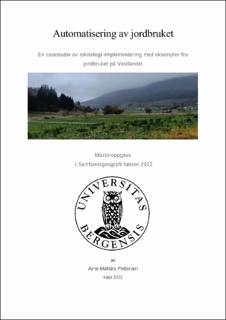Automatisering av jordbruket: en casestudie av teknologi-implementering med eksempler fra jordbruket på Vestlandet
Master thesis
Permanent lenke
https://hdl.handle.net/11250/3045479Utgivelsesdato
2022-11-18Metadata
Vis full innførselSamlinger
- Master theses [140]
Sammendrag
Things are happening on the farm today! There is enormous potential for innovation found in improvements of sensors and advanced digital networks. These technologies enable the entry of robotic smart systems on the farm in a greater way than before and this study tries to identify how current robot technology spreads in the agriculture located in Western Norway county. The theoretical perspective for this study is Technology Diffusion, and aims to identify experiences which purchase, installation, and use of three selected farm-equipment technologies: Milking Robots, Nofence, Auto-steered tractors. Much of the literature in the field argues that the implementation of automatic technologies in farming will lead to more efficient productive and flexible workday arrangements The empirical evidence is based on 8 interviews with farmers who have acquired and uses on of these technologies. Furthermore, these interviews are complemented with information based on secondary sources such as electronical newspapers, secondary statistics, websites, governmental reports conference presentations and informal key informants collected before, during and after the fieldwork session. A summary of my main findings is the following: 1) Effects of technology adoption include partly how the technological equipment works in the given setting, and partly how the equipment produces effects in the form of changes in the farm's design and practice in relation to the work tasks carried out. 2) The technologies are conditioned by as well as affect work organization and practice. Initially the technology implementation is also conditioned by certain structural requirements linked to barn structure and work arrangements. The study identifies technology diffusion characteristics that we recognize from Rogers and Hägerstrand's diffusion models. Regarding the individuals that comprises this study this do both involve the technology geeks being the eager early adopters to the other end of the scale which can be described as the latecomers. The findings even show that some also regret this investment as it did not meet the expectation of flexibility and smooth operation as they had expected.
